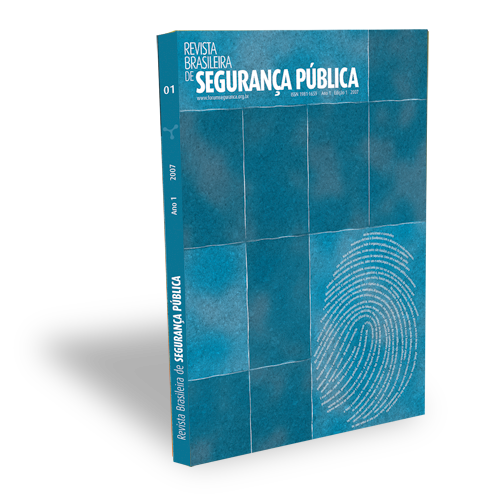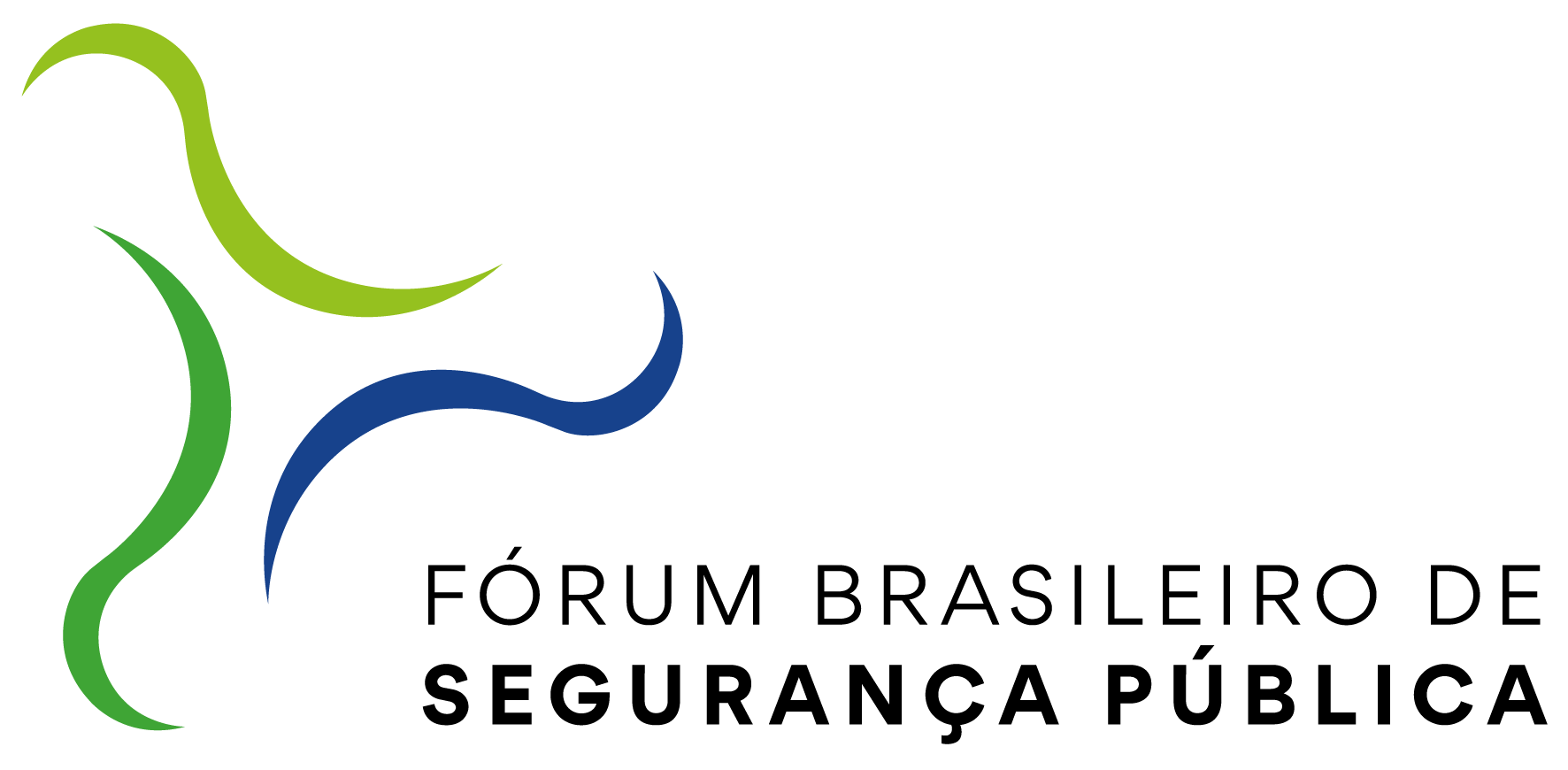Forças armadas e policiamento
DOI:
https://doi.org/10.31060/rbsp.2007.v1.n1.6Palavras-chave:
Segurança Pública, Forças Armadas, Polícia, Brasil.Resumo
Este ensaio focaliza duas questões sobre o uso das Forças Armadas no policiamento: “As Forças Armadas devem serusadas na segurança pública?” e “Quais são as conseqüências desse uso?”. A estas se acrescenta ainda uma terceiraquestão — “E daí?” —, que permite a consideração do uso interno das Forças Armadas e do uso externo das polícias,da duplicação das capacitações militares e policiais, da disponibilização de todos os recursos necessários às políciaspara prescindir das Forças Armadas e da normatização da sua ação no policiamento. O ensaio tem como questãocentral o mandato policial e suas implicações em termos conceituais, políticos, legais e organizacionais.
Downloads
Referências
ACKROYD, WS. (1991), “Military Professionalism, Education, and Political Behaviour in Mexico”, Armed Forces and Society, v.18, no.1: html.
ASHKENAZY, D. (1994), The Military in the Service of Society & Democracy: the Challenge of the Dual Role Military, Westport, CT: Greenwood.
BANTON, M. (1964), The policeman in the community. Basic Books.
BAYLEY, DH. (1985), Patterns of Policing: A Comparative International Perspective. New Haven: Rutdgers University Press.
BAYLEY, DH & C SHEARING. (2001), The New Structure of Policing: description, conceptualization and research agenda. Washington, DC: National Institute of Justice.
BITTNER, E. (1990), Aspects of Police Work. Boston, Mass: Northeastern University Press.
BLANCO, CA (2006), La Reforma Policial en Mexico. Mexico: Escuela de Guerra Naval.
BOWDEN, T. (1977), “Policing Palestine 1920-1936” in GL Mosse (ed.), Police Forces in History, pp. 115-130. Beverly Hills: Sage Publications.
BROUDEUR, J P. (1992), “High policing and low policing” in: KRE McCormick and LA Visano (eds.), Understanding Policing, pp. 277-299. Toronto: Canadian Scholar’s Press.
CHALON, M. et al (2001), Urban Safety and Good Governance: the role of the police. Nairobi: International Centre for the Prevention of Crime.
COHEN, EA. (2002), Supreme Command: Soldiers, Statesmen, and Leadership in Wartime. New York: Free Press.
COLES, HL & AK Weinberg. (2004), Civil Affairs: Soldiers Become Governors. Washington: Center of Military History, U.S. Army.
CORDNER, GW et al, eds. (1996), Police Operations: analysis and evaluation. Cincinnati, OH: Anderson Publishing Co.
CRITCHLEY, TA (1992), “The New Police in London, 1750-1830” in: KRE McCormick and LA Visano (eds.), Understanding Policing, pp. 85-112. Toronto: Canadian Scholar’s Press.
COTTEY, A et al. (2002), “The Second Generation Problematic: Rethinking Democracy and Civil Military Relations.” Armed Forces & Security, v. 29, n. 1, Fall 2002, pp. 31-56.
CUSSON, M. (1999), “Qu’estce que la securité intérieure?”, electronic document, University of Montreal.
DESCH, M. (1999), Civilian Control of the Military: The Changing Security Environment. Baltimore, MD: John Hopkins University Press.
ENSALACO, M. (1995), “Military Prerogatives and the Stalemate of Chilean Civil Military Relations”, Armed Forces and Society, v. 21 n. 2: html.
ERICSON, RV. (1992), “The Police as reproducers of order” in: KRE McCormick and LA Visano (eds.), Understanding Policing, pp. 163-208. Toronto: Canadian Scholar’s Press.
ETZIONI HALEVY, E. (1996), “Civil Military Relations and Democracy: The Case of the Military Political Elites’ Connection in Israel”, Armed Forces and Society, v. 22 n. 3: html.
FEAVER, P. (1996), “The Civil Military Problematique: Huntington, Janowitz, and the Question of Civilian Control.” Armed Forces and Society 23, pp. 149-178.
FEAVER, P & RH KOHN. (2001), Soldiers and Civilians: The Civil Military Gap and American National Security. Cambridge, MA: MIT Press.
FELTES, T. (2003),Frischer Wind und Aufbruch zu neuen Ufern? Was gibt es Neues zum Thema Polizeiforschung und Polizeiwissenschaft?’, eletronic document, [www.thomasfeltes.de/Literatur.htm].
FIELDING, NG. (2002), “Theorizing Community Policing”, British Journal of Criminology, 42, pp. 147-163.
FINER, SE. (1988), The Man on Horseback: The Role of the Military in Politics. 2nd, enlarged ed., rev., and updated. Boulder, CO: Westview Press.
FRIEDBURG, A. (1992), “Why Didn’t the United States Become a Garrison State?” International Security 16, n. 4, pp. 109-137.
GIBSON, CP & DM SNIDER. (1999), “Civil Military Relations and the Potential to Influence”, Armed Forces and Society, 20(2): html.
GOLDSTEIN, H. (1977), Policing a Free Society. Ballinger Pub Co.
HALBERSTADT, H. (1994), Swat Team: Police Special Weapons and Tactics. Motorbooks International.HANSEN, AS. (2002), From Congo to Kosovo: Civilian Police in Peace Operations. London: IISS / Oxford University Press.
HARRING, SL & MCMULLIN, LM (1992), “The Buffalo Police 1832-1900” in: KRE McCormick and LA Visano (eds.), Understanding Policing, pp. 129-151. Toronto: Canadian Scholar’s Press.HEAL, C. (2000), Sound Doctrine: a tactical primer. New York: antern Books
HORTON, C. (1995), Policing Policy in France. London: Policy Studies Institute.
HUNTER, W. (1997), Eroding Military Influence in Brazil: Politicians Against Soldiers. Chapel Hill, NC: University of North Carolina Press.
HUNTINGTON, SP. (1957), The Soldier and the State: The Theory and Politics of Civil Military Relations. Cambridge, MA: Belknap Press of Harvard University Press.
JANOWITZ, M. (1960), The Professional Soldier: A Social and Political Portrait. Chicago: Chicago U Press.
JONES, T & T NEWBURN (2002), “The transformation of policing? understanding current trends in policing systems”, British Journal of Criminology, 42, pp. 120-146.
KAPPELER, VE et al. (2000), : The Mythology of Crime and Criminal Justice. Prospect Heights, Ill.: Waveland Press.
KATZENSTEIN, P. (1997), Cultural Norms and National Security. Ithaca, NY: Cornell University Press.
KELLY, MJ. (1998), “Legitimacy and the Public Security Function’ in Robert B Oakley, Michael J Dziedzic and Eliot M Goldberg, eds., Policing the New World Disorder: peace operations and public security. Washington DC: National Defense University Press, pp. 399-432.
KLOCKARS, CB. (1985), The Idea of Police. London: Sage.
KOHLER, ED. (1977), “The Crisis in the Prussian Schutzpolizei 1930-1932’” in: GL Mosse (ed.), Police Forces in History. Beverly Hills: Sage Publications, pp. 131-150.
KUMMEL, G. (2002), “The Military and its Civilian Environment: Reflections on a Theory of Civil Military Relations.” Connections: The Quarterly Journal, vol. 1, no. 4, pp. 63-82.
LASSWELL, H. (1941), “The Garrison State.” The American Journal of Sociology 46, pp. 455-468.
LOVEMAN, B & T DAVIES, Jr., eds. (1997), The Politics of Anti-Politics: The Military in Latin America. Wilmington, DE: Scholarly Resources.
MANNING, PK. (2004), “Some Observations Concerning a Theory of Democratic Policing’ (Draft), Conference on Police Violence, Bochom, Germany, April. 8 p.
MARES, DR. (ed.), (1998), Civil-Military Relations: Building Democracy and Regional Security in Latin America, Southern Asia and Central Europe, Boulder: Westview Press.
MIJARES, T et al. (2000), The Management of Police Specialized Tactical Units. London: Charles C Thomas Pub Ltd.
MOSKOS, C. et al (2000), The Postmodern Military: Armed Forces after the Cold War. New York, NY: Oxford University Press.
MUIR Jr, WK. (1977), Police: Streetcorner politicians. Chicago: The University of Chicago Press.
MUNIZ, J. & D. PROENÇA Jr (2003), “Police Use of Force: The Rule of Law and Full Accountability”, Comparative Models of Accountability Seminar.
INACIPE, Ciudad de Mexico, 29-30 October, 10 p.
NEOCLEOUS, M. (2000), The Fabrication of Social Order: a critical theory of police power. London: Pluto Press.
NIELSEN, S. (2001), Political Control Over the Use of Force: A Clausewitzian Perspective. Carlisle Barracks, PA: Strategic Studies Institute, Army War College.
NORDEN, DL. (1996), “Redefining Political-Military Relations in Latin America: Issues of the New Democratic Era”, Armed Forces and Society, v. 22, n. 3: html.
OAKLEY, RB et al, eds. (1998), Policing the New World Disorder: peace operations and public security. Washington: National Defense University Press.
PERLMUTTER, A. (1977), The Military and Politics in Modern Times: On Professionals, Praetorians, and Revolutionary Soldiers. New Haven: Yale University Press.
PROENÇA Jr, D. (2003), “Some Considerations on the Theoretical Standing of Peacekeeping Operations”. In: Low Intensity Conflict and Law Enforcement 9(3), pp. 1-34.
PROENÇA Jr, D & J MUNIZ. (2006), “‘Stop or I’ll call the Police!’ The Idea of Police, or the effects of police encounters over time”, British Journal of Criminology, 46, pp. 234-257.
RAHTZ, H. (2003), Understanding Police Use of Force. Monsey: Criminal Justice Press.REINER, R. (1992), The Politics of the Police. Toronto: University of Toronto Press.
ROBINSON, C et al. (1994), Police in Contradiction: the evolution of the police function in society. Westport, Conn: Greenwood Press.
ROUQUIE, A. (1996), “Demilitarization and the Institutionalization of Military dominated Polities in Latin America.” in Transitions from Authoritarian Rule: Prospects for Democracy. Edited by G O’Donnell et al. Baltimore, MD: John Hopkins University Press.
RUSSELL, RL. (2004), “Civilian Masters and Military Servants.” Political Science Quarterly, v. 119, n. 1, pp. 171-178.
SCHMIDL, EA. (1998), “Police Functions in Peace Operations’ in RB Oakley et al, eds., Policing the New World Disorder Washington: National Defense University Press, pp. 19-40.
SIGMUND, P. (1993), “Approaches to the Study of the Military in Latin America.” Comparative Politics 26, pp. 111-122.
SKOLNICK, JH. (1994 [1966]), Justice Without Trial: Law Enforcement in Democratic Society. New York: Macmillan College Publishing Company, 3rd ed.
STOKES, LD. (1977), “Otto Ohlendorf, the Sicherheitdienst and Public Opinion in Nazi Germany’ in: GL Mosse (ed.), Police Forces in History. Beverly Hills: Sage Publications, pp. 231-262.
SWANSON, GW. (1977), “The Ottoman Police” in: GL Mosse (ed.), Police Forces in History. Beverly Hills: Sage Publications, pp. 39-56.
US – Department of Defense (2002a). 21st Century U.S. Army Military Police Operations Field Manual. Washington: GPO.
US – Department of Defense (2002b). Milspeersman 1630-010 – Naval Security Forces Ashore and Afloat. Washington: Department of Defense.
VALENZUELA, S. (1992), “Democratic Consolidation in Post Transitional Settings: Notion, Process, and Facilitating Conditions.” In Issues in Democratic Consolidation: The New South American Democracies in Comparative Perspective. Scott Mainwaring et al., eds. South Bend, IN: University of Notre Dame Press, 1992, pp. 57-104.
WALKER, S. (2004), “Science and Politics in Police Research: reflections on their tangled relationship”, The Annals of the American Academy of Political and Social Science, 593/1, pp. 137-155.
WHITAKER, GP. (1996), “What is Patrol Work?” in: Cordner, Gary W et al, ed. (1996), Police Operations – analysis and evaluation. Prospect Heights, Ill.: Anderson Pub Co. pp. 55-70.
ZAGORSKI, PW. (1992), Democracy vs. National Security: Civil-Military Relations in Latin America, Boulder, CO: Lynne Rienner Publishers.
Downloads
Publicado
Como Citar
Edição
Seção
Licença
Copyright (c) 2012 Revista Brasileira de Segurança Pública

Este trabalho está licenciado sob uma licença Creative Commons Attribution 4.0 International License.
Licenciamento
A Revista Brasileira de Segurança Pública usa a Licença Creative Commons como forma de licenciamento para suas obras publicadas. A licença utilizada segue o modelo CC BY 4.0 - Attribution 4.0 International.
Para consultar os dirietos permitidos direcione-se para a licença completa ou para a nossa página de Direitos dos autores e Licenças.



